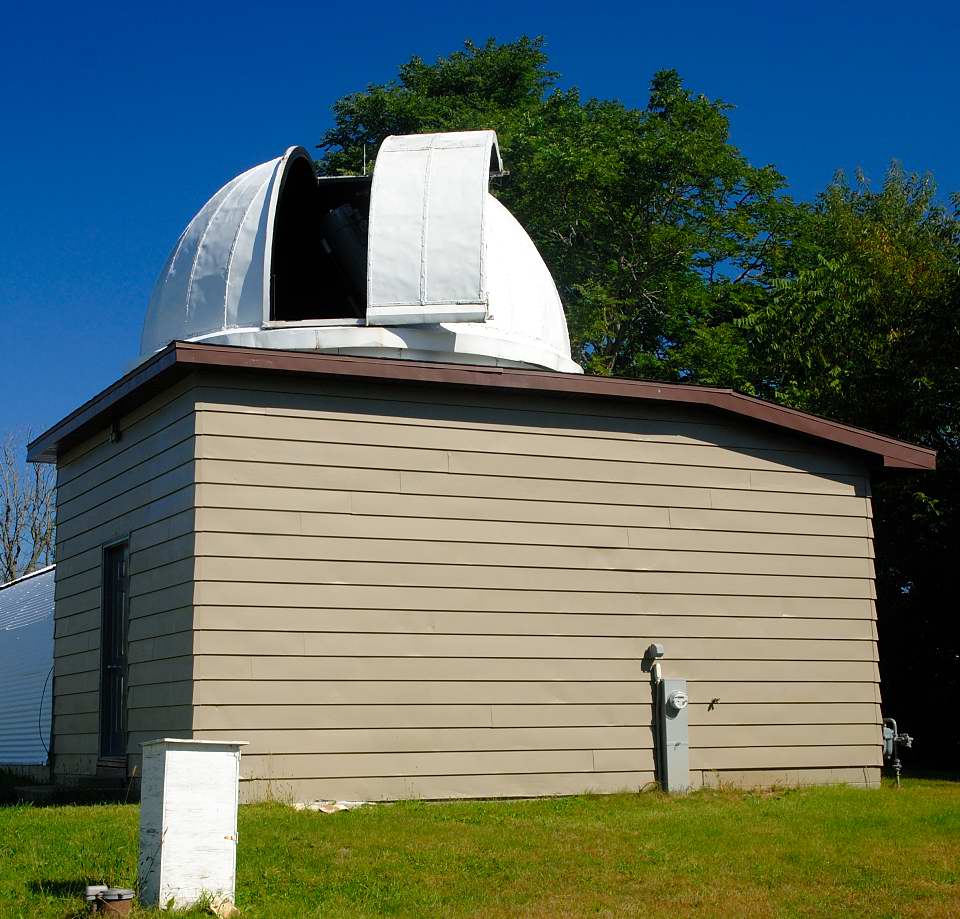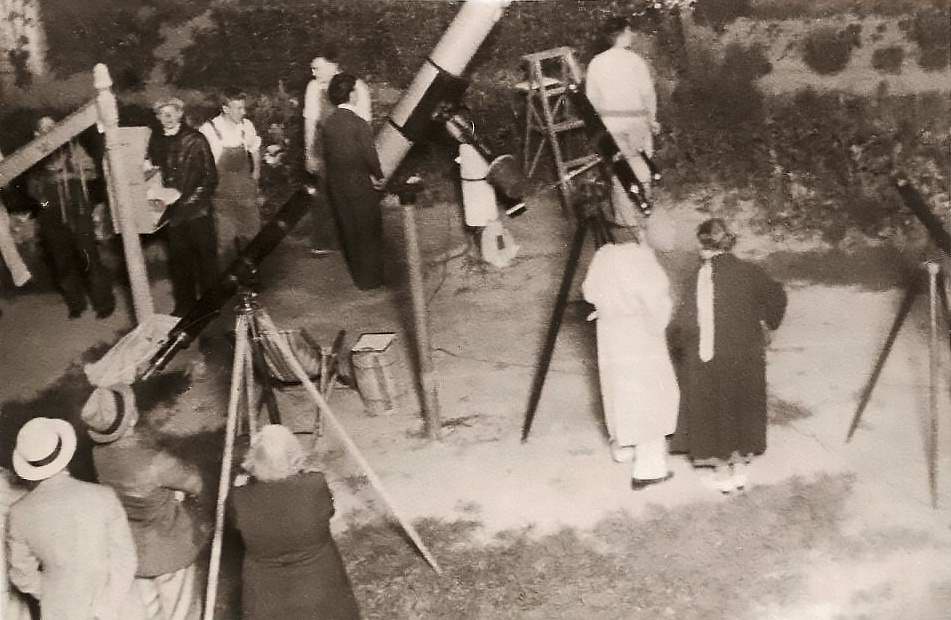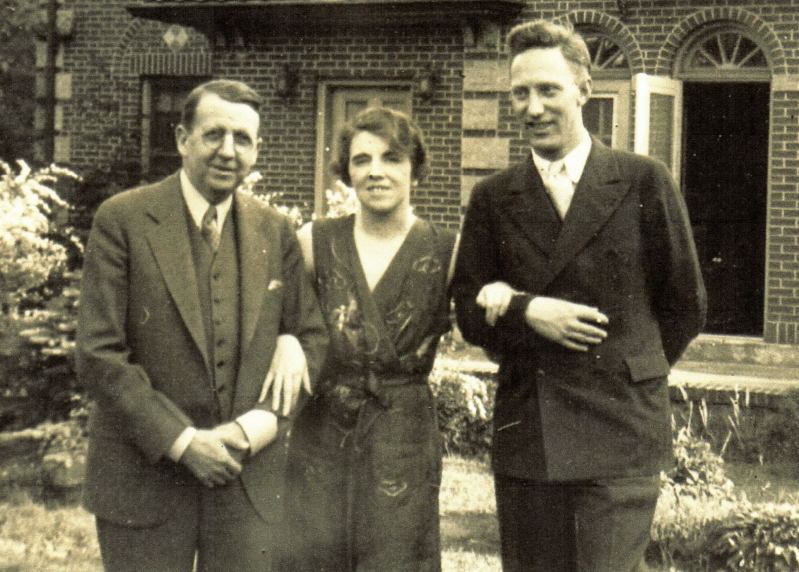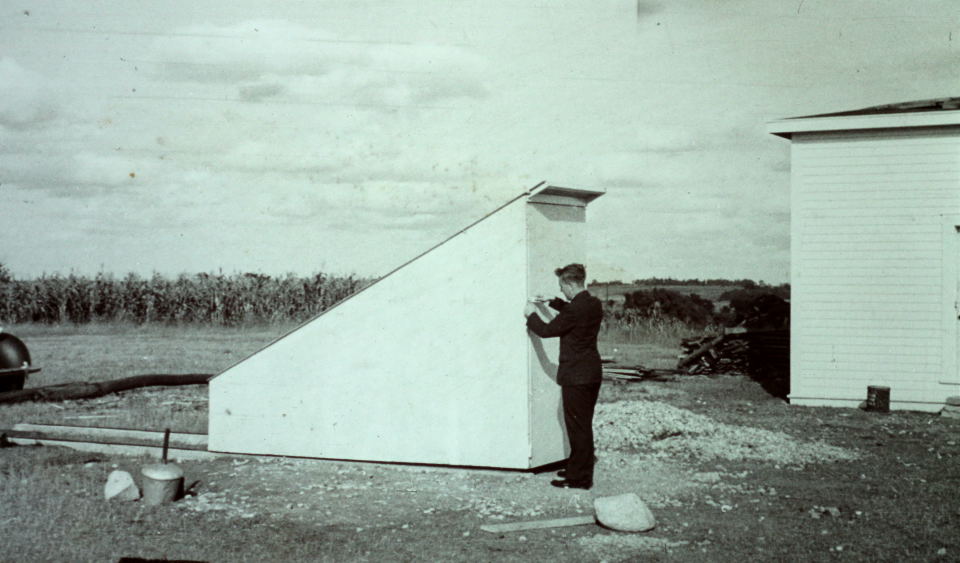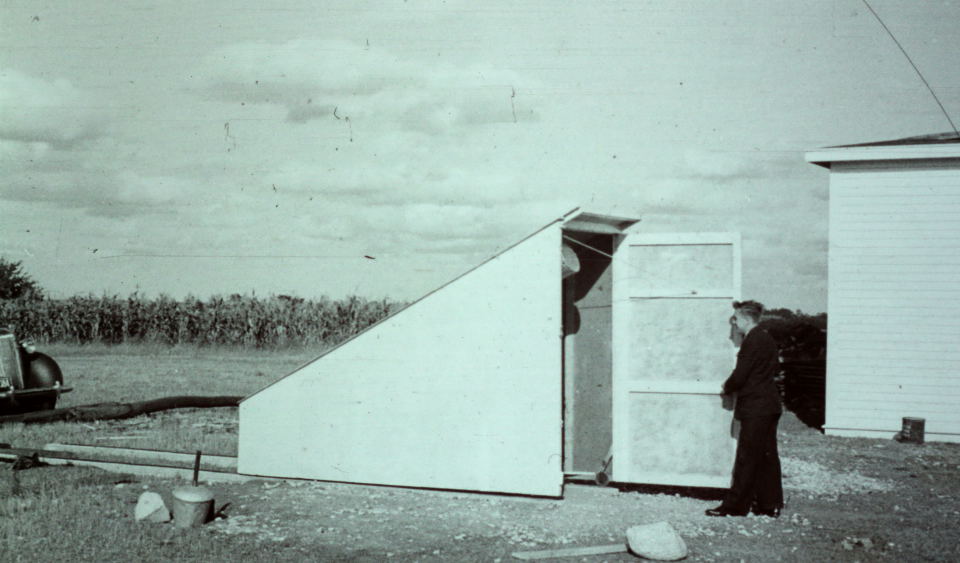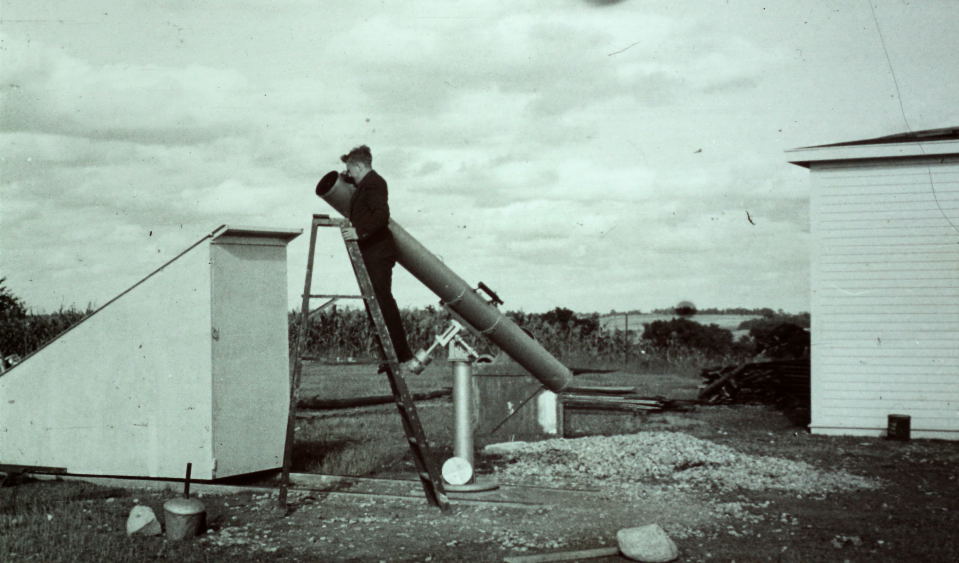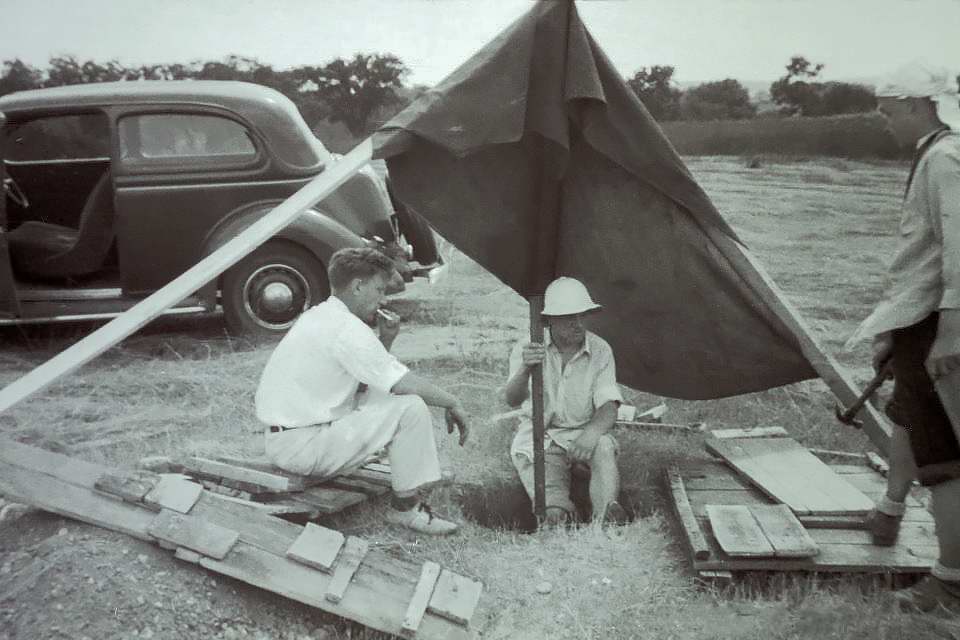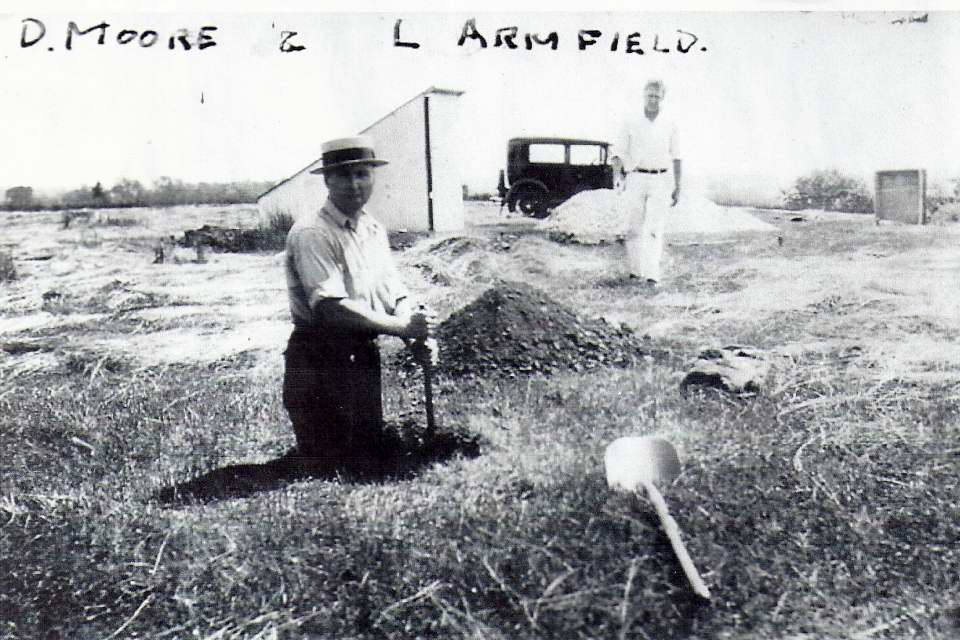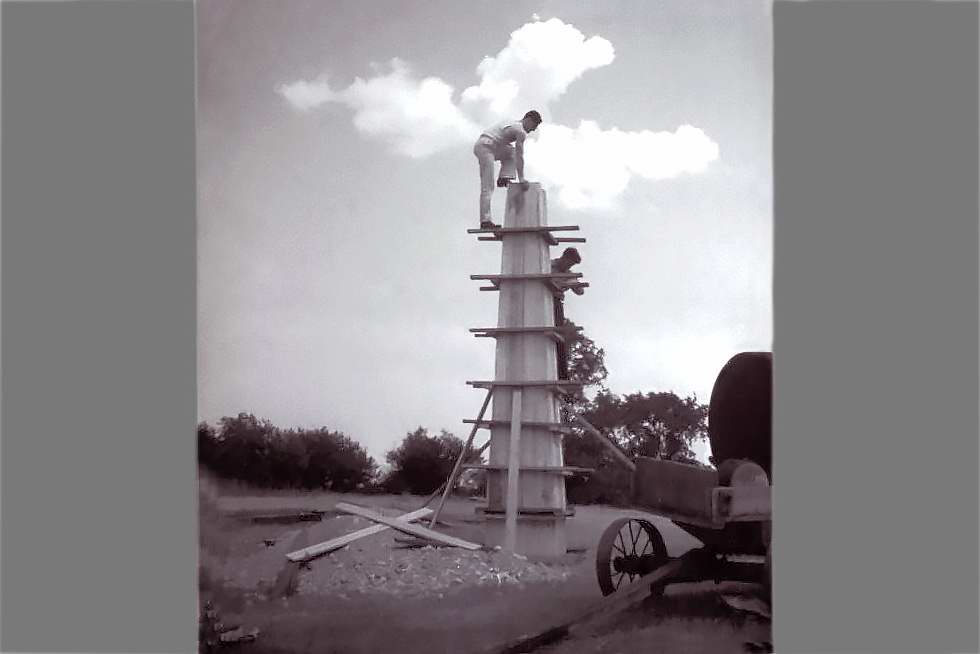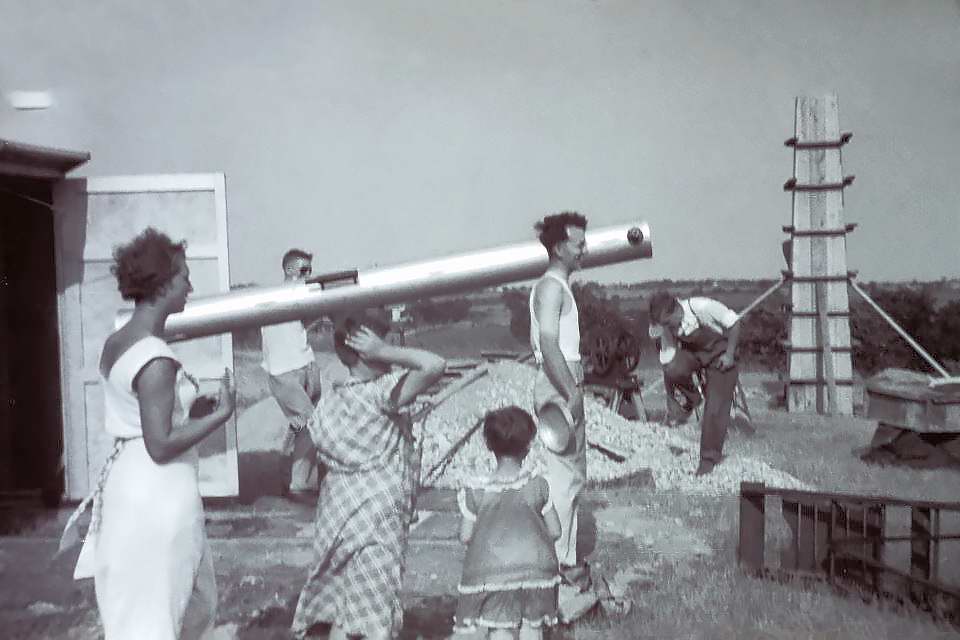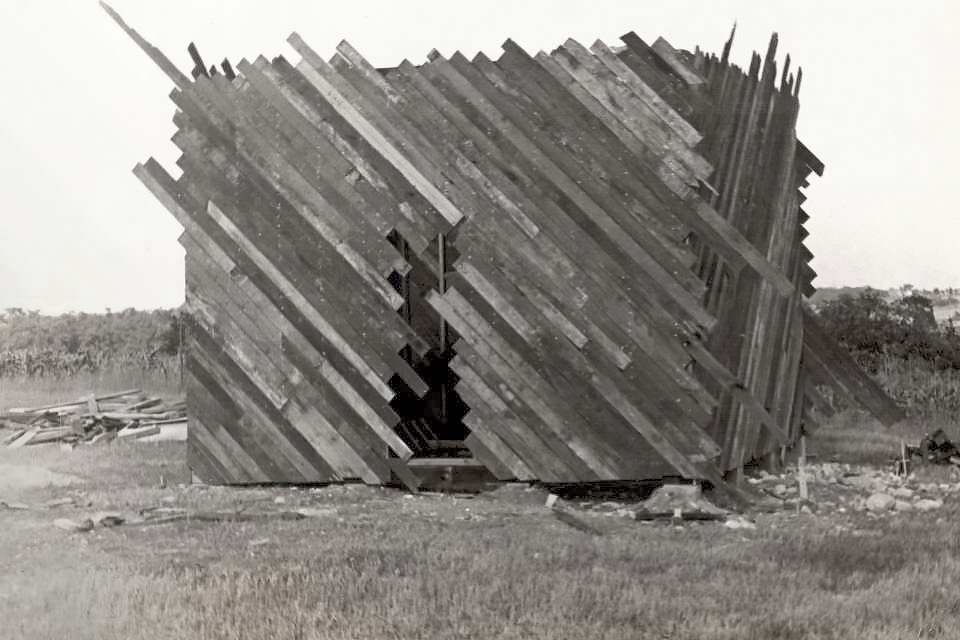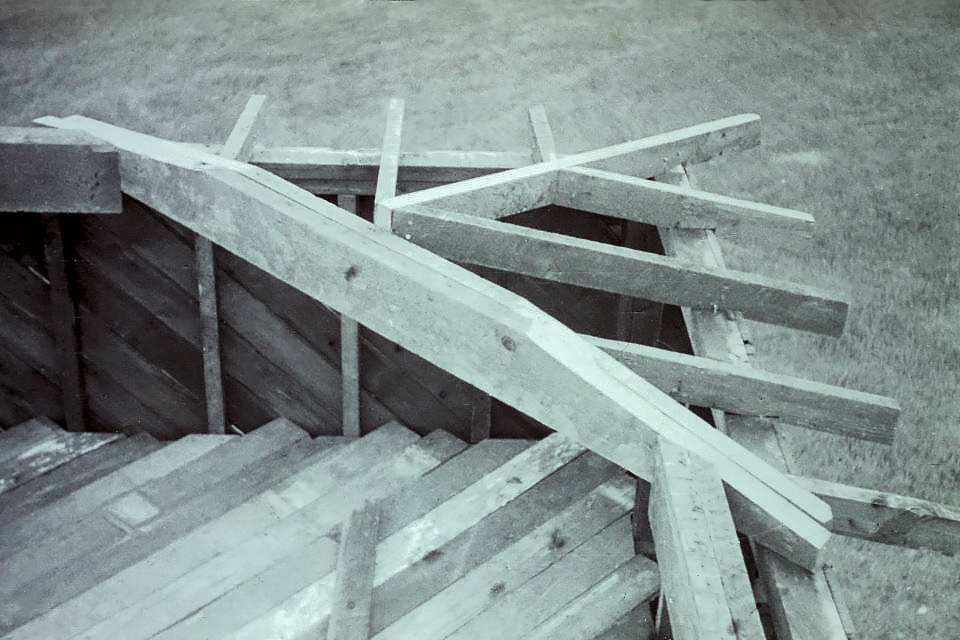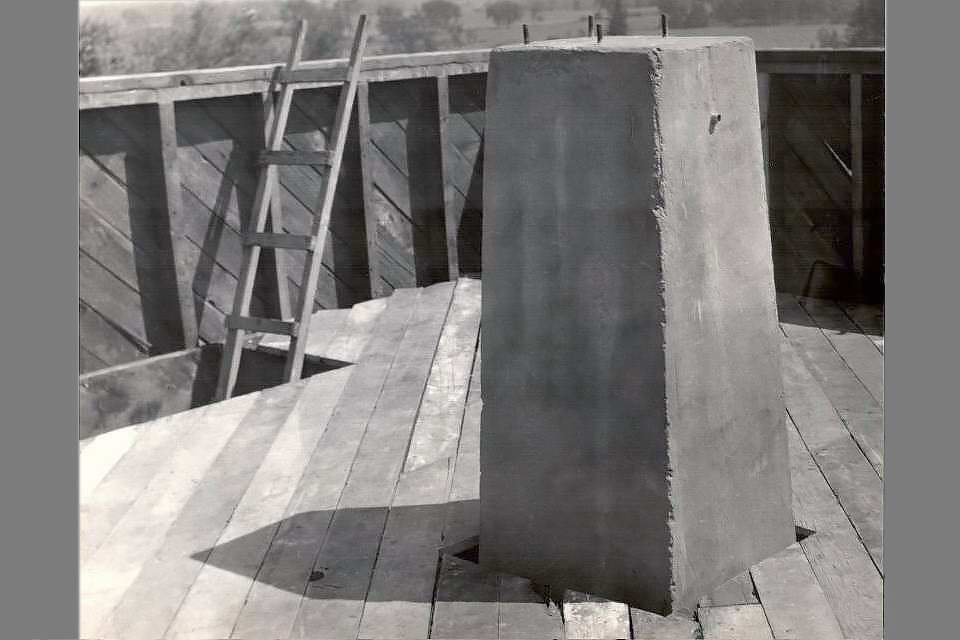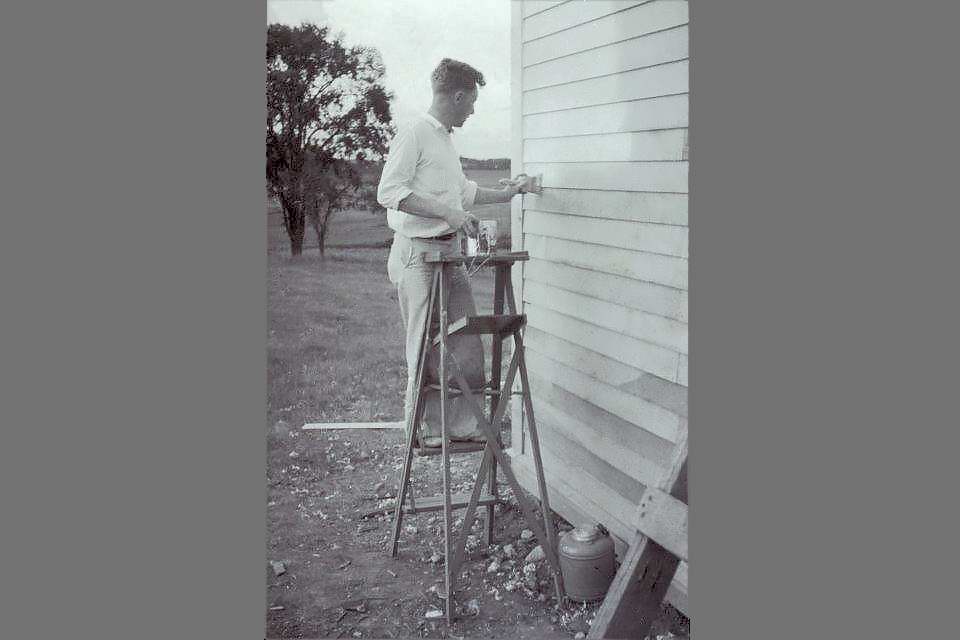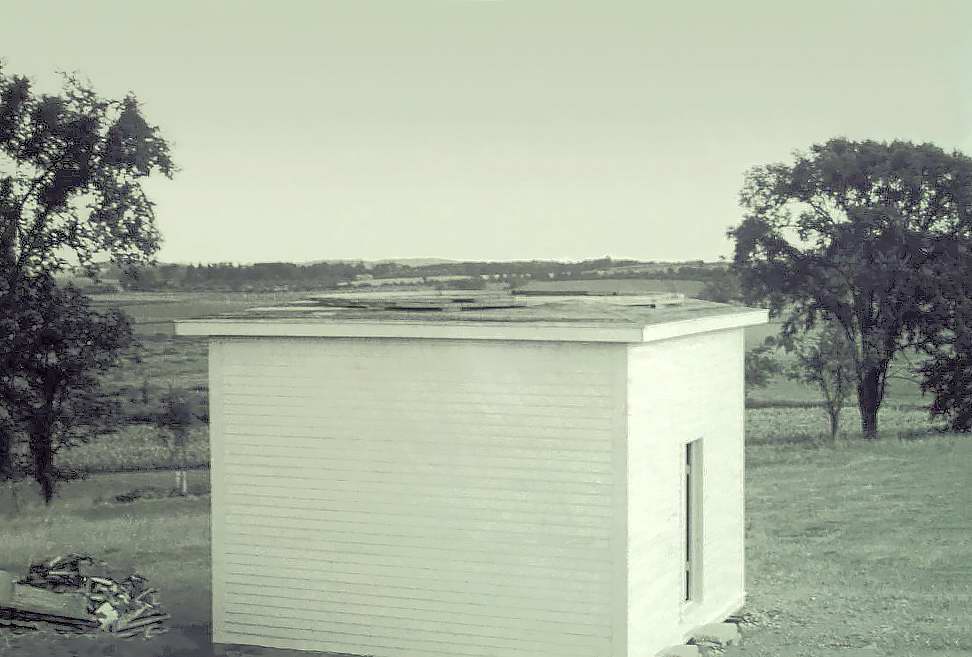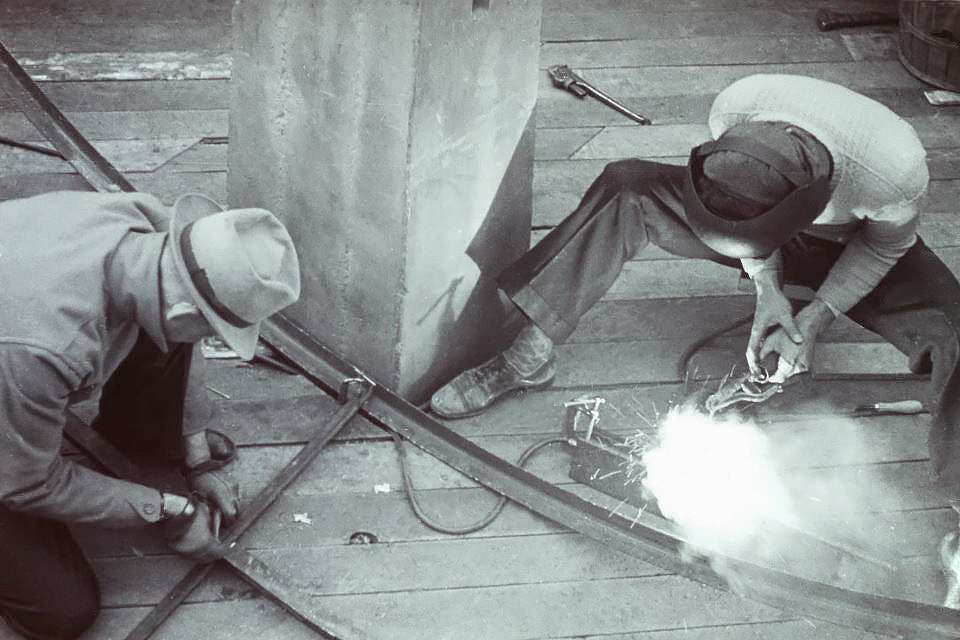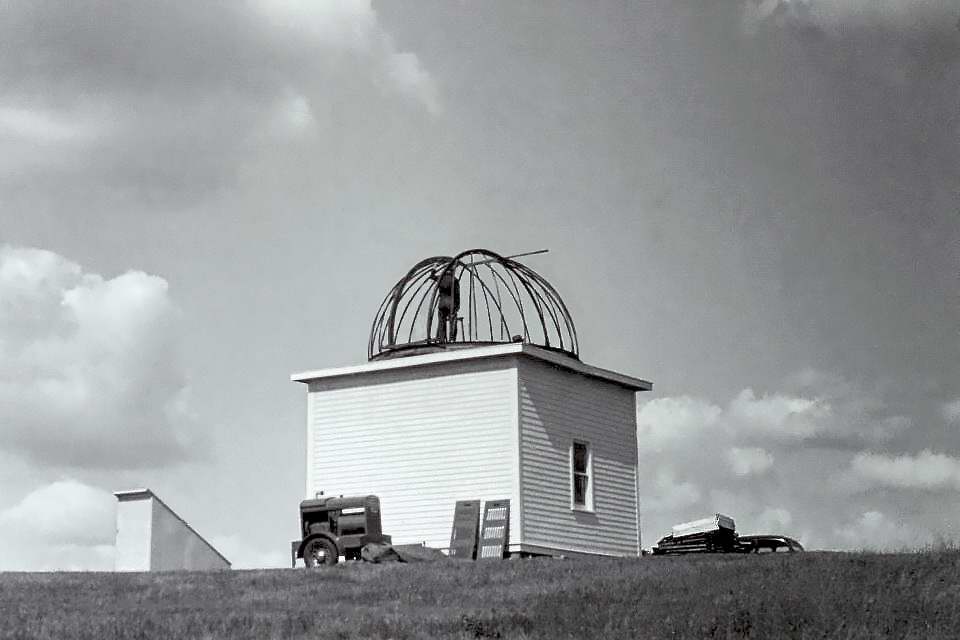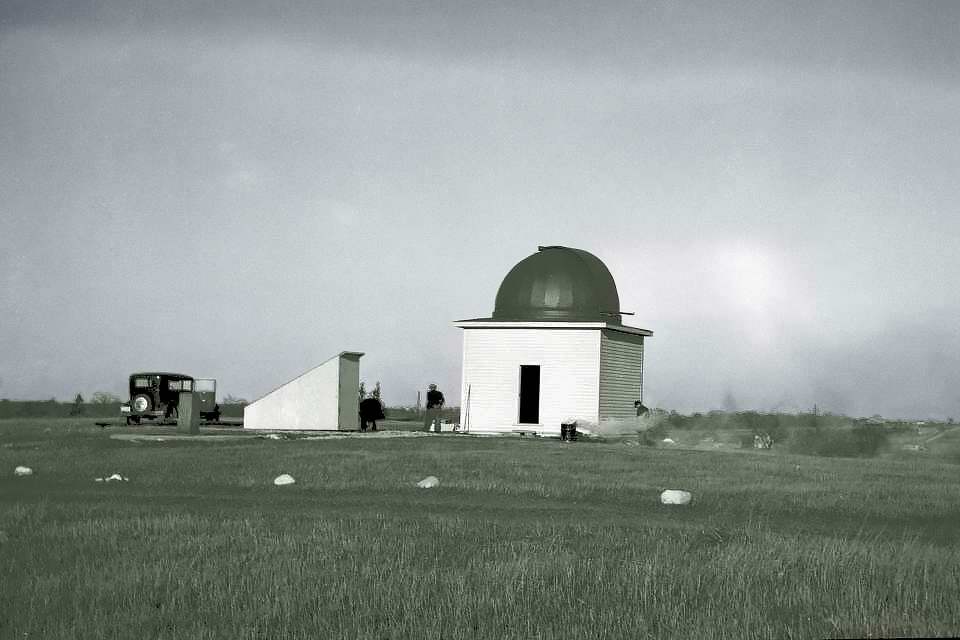Luverne Armfield
1906-1977
Luverne Armfield is considered the founder of the Milwaukee Astronomical Society. Though he was not the only founder of our organization, he was the leader and in those early years his home was the epicenter of the club's activities. And he took us down the path of doing scientifically valuable observations with our eyes and telescopes. He inspired the members and did it by example. He also supplied considerable monetary assistance.
Though Milwaukee would have eventually had an astronomy club or society (it was and is simply too big not to), it would have been formed much later and wouldn't nearly be the organization that it is today. So we owe a large debt to Armfield. It is very fitting that our first domed observatory built in 1937 is called the Armfield Observatory.
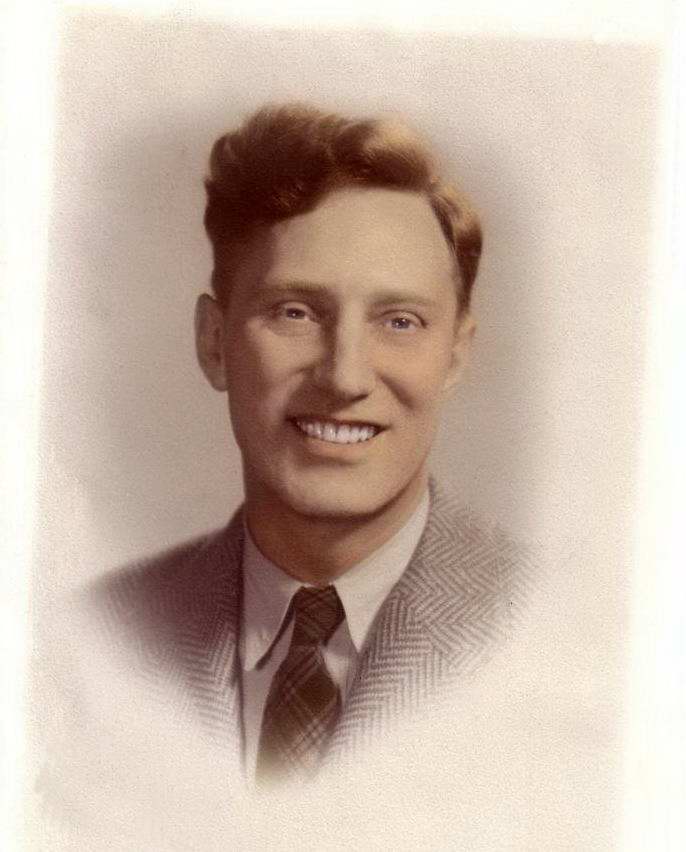 Luverne Eugene Armfield was born in in Fennimore, Wisconsin on March 2, 1906. He attended Milwaukee Technical College
and the Milwaukee branch of the University of Wisconsin taking courses in mathematics and electrical engineering.
In 1927 he held a job at the Wisconsin Telephone Company as an Equipment Engineer. The following year he married Dorothy Elizabeth Haertel.
Luverne Eugene Armfield was born in in Fennimore, Wisconsin on March 2, 1906. He attended Milwaukee Technical College
and the Milwaukee branch of the University of Wisconsin taking courses in mathematics and electrical engineering.
In 1927 he held a job at the Wisconsin Telephone Company as an Equipment Engineer. The following year he married Dorothy Elizabeth Haertel.
Armfield's first interest in astronomy was in building telescopes. That was in 1927 when he started to grind his first mirror. Two years later that telescope with the 8-inch mirror was completed and only then did he begin observing the heavens and soon after became interested in the science of astronomy.
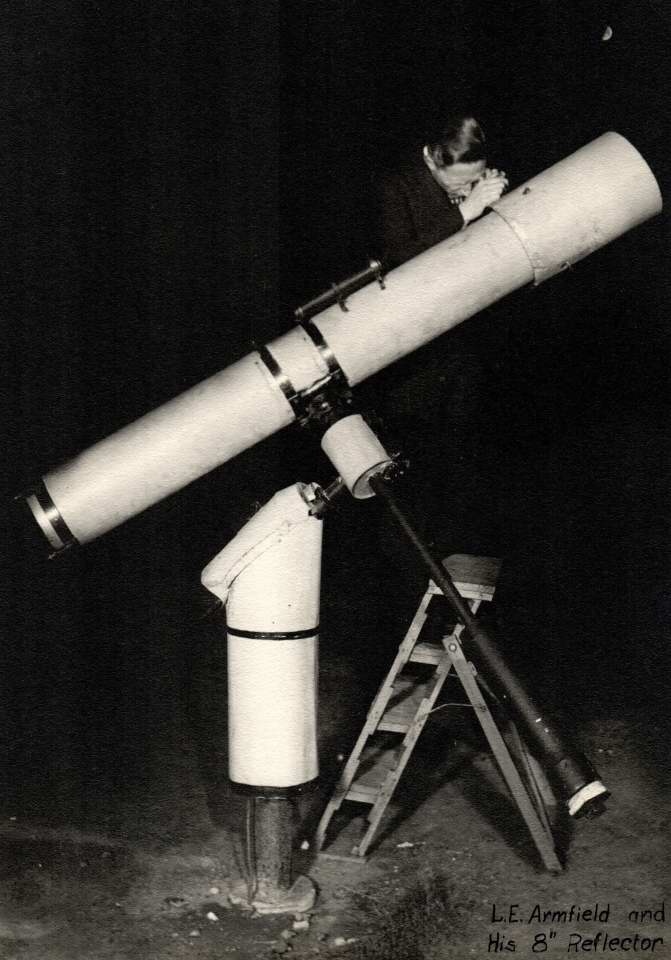 By 1931 he started observing variable stars, an endeavor which allowed amateurs to contribute to the science of astronomy.
He did that through the American Association of Variable Star Observers (AAVSO) and was assigned the AAVSO observer code
of simply "A" indicating he was the first observer of the organization with a last name starting with A.
By 1931 he started observing variable stars, an endeavor which allowed amateurs to contribute to the science of astronomy.
He did that through the American Association of Variable Star Observers (AAVSO) and was assigned the AAVSO observer code
of simply "A" indicating he was the first observer of the organization with a last name starting with A.
When he became employed in Milwaukee, he bought a house in the city of West Allis, a suburb of Milwaukee and installed the 8-inch reflector in his backyard where he did all of his astronomy. He would eventually add a 10-inch reflector. But along with his variable star observations, he also became an avid observer of meteors, both doing counts and then trail plotting. And along the way he met other amateur astronomers who were regularly invited to observe from his backyard.
1932
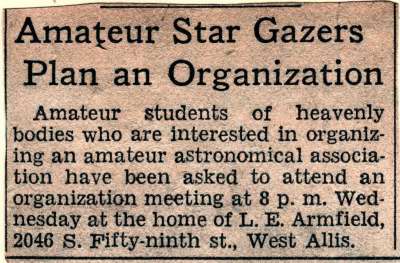 In 1932 with a couple
of his astronomy friends (which included
Edwin Arthur de la Rulle) thought they should
form an astronomy club. To gear the interest, Armfield took out an ad which was placed in the Sunday edition
of the Milwaukee Journal of September 18th.
In 1932 with a couple
of his astronomy friends (which included
Edwin Arthur de la Rulle) thought they should
form an astronomy club. To gear the interest, Armfield took out an ad which was placed in the Sunday edition
of the Milwaukee Journal of September 18th.
"Amateur star gazers plan an organization. Amateur students of heavenly bodies who are interested in organizing an amateur astronomical association have been asked to attend an organization meeting at 8 p.m. at the home of L.E. Armfield, 2046 S. 59th St., West Allis, Wisconsin."
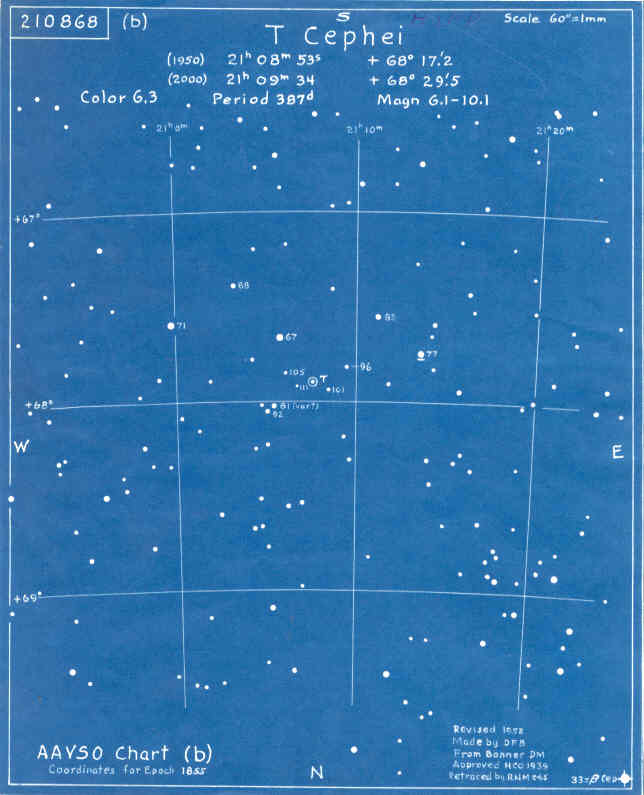 The meeting went well and as a result they formed the Milwaukee Astronomical Society (MAS) and there were
18 charter members. Edwin Arthur de la Rulle was chosen as the President with Armfield the Secretary/Treasurer.
Of course they planned on having regular meetings as any club would, but they would immediately distinguish
themselves because they began regular observing sessions in Armfield's backyard. The members would observe through
Armfield's scopes or they would bring their own to set up. Besides the so-called "fun" viewing, with Armfield's
leadership they did variable star and meteor observing.
The meeting went well and as a result they formed the Milwaukee Astronomical Society (MAS) and there were
18 charter members. Edwin Arthur de la Rulle was chosen as the President with Armfield the Secretary/Treasurer.
Of course they planned on having regular meetings as any club would, but they would immediately distinguish
themselves because they began regular observing sessions in Armfield's backyard. The members would observe through
Armfield's scopes or they would bring their own to set up. Besides the so-called "fun" viewing, with Armfield's
leadership they did variable star and meteor observing.
Nightly star party in Luverne Armfield's backyard.
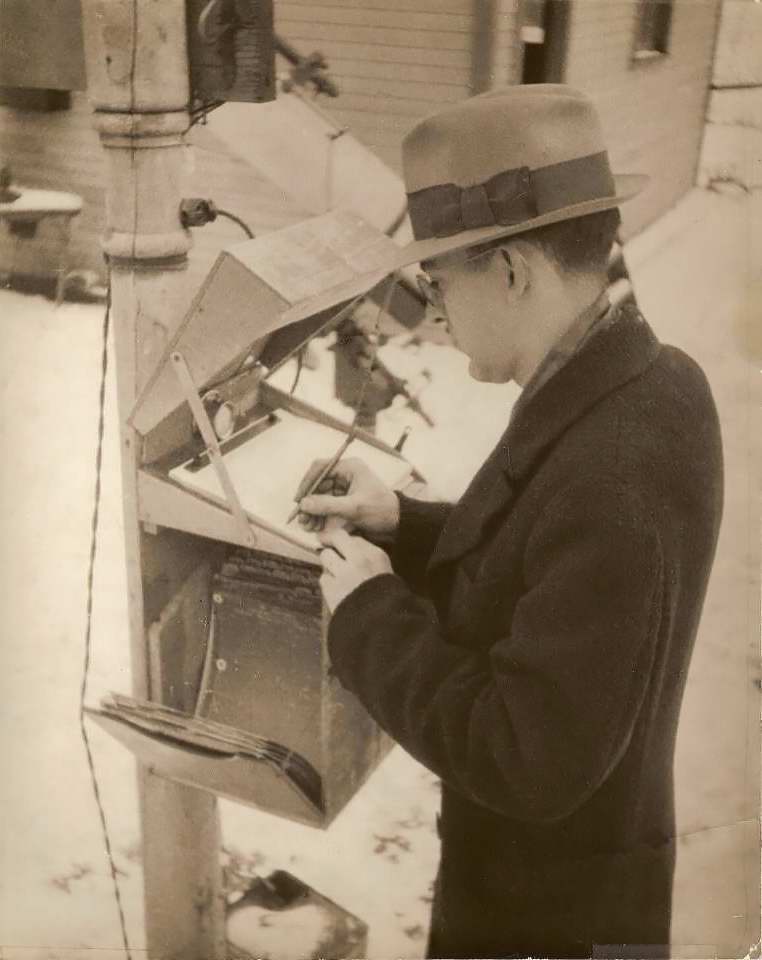 The following month there was another general meeting and 12 more members signed up and one of the new members was
Edward Halbach (at left),
an engineer attending Marquette University getting a MA in Physics. He immediately started observing variable stars and meteors.
In the picture on the left, he's in Armfield's backyard recording a variable star estimate.
In time Halbach would pick up the mantle of scientific observing pioneered by Armfield.
The following month there was another general meeting and 12 more members signed up and one of the new members was
Edward Halbach (at left),
an engineer attending Marquette University getting a MA in Physics. He immediately started observing variable stars and meteors.
In the picture on the left, he's in Armfield's backyard recording a variable star estimate.
In time Halbach would pick up the mantle of scientific observing pioneered by Armfield.
1933
By 1933, Armfield had become a member of the American Meteor Society (AMS) and now directed the MAS in group meteor watches. He was essentially the MAS Meteor Director. The first published watch was the 1933 Perseid shower where he, his wife, Dorothy, and 6 MAS members were divided into 3 groups: Milwaukee and North and South Milwaukee. With the most being separated by 50 miles with simultaneous plotting which could then be used to make height calculations of the meteors. This was regarded as a rehearsal for the upcoming Leonid Meteor Shower, which was anticipated to be a repeat of the fantastic 1833 meteor storm.
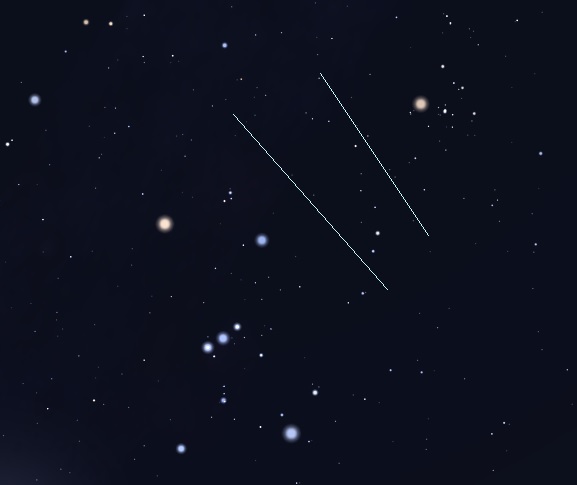 Meteor observing was one important way that amateurs could contribute to science. Doing meteor counts
and establishing radiant points had long been the way amateurs could contribute, but if you could get a
good enough plot for the same meteor seen by two observers 25-125 miles apart, a parallax could be
calculated and, hence, a height calculation could be made.
Meteor observing was one important way that amateurs could contribute to science. Doing meteor counts
and establishing radiant points had long been the way amateurs could contribute, but if you could get a
good enough plot for the same meteor seen by two observers 25-125 miles apart, a parallax could be
calculated and, hence, a height calculation could be made.
Though Armfield made a very large campaign for the Leonid shower with 25 observers widely scattered with
stations in Wisconsin, Illinois, and Indiana, the storm never materialized. And largely due to the inexperience
of too many of the observers, only 18 meteor heights were calculated from all the data. However, Armfield's
efforts were noticed by Dr. Charles Oliver (the Director of the AMS) and consequently appointed him AMS Regional
Director for Wisconsin-Northern Illinois (WI-NIL) region.
1933 ended with the MAS plotting and counting 1120 meteors. Armfield mapped 102 and Dorothy Armfield mapped 189.
Armfield also reported seeing 33 telescopic meteors while observing variable stars and then another 100 which
were a daylight shower which he detected simply by chance. Because of his position as the WI-NIL Director,
he turned over the role of MAS Meteor Director to Ed Halbach.
 By the end of 1933 the MAS had some 100 members with an additional 30 members in the junior auxiliary (members
not yet 18 years of age) - it was getting very crowded in Armfield's backyard! So it was hardly surprising that
there was a lot of discussion about what they called their "castle in the air" which is what they labeled their
dream of establishing a real observatory outside of Milwaukee in a dark location. As a result they did what
organizations do: they formed a committee called the Observatory Site Search Team of which Armfield was a member.
But the harsh reality of the Great Depression made this a pipe dream and was viewed as just a mental exercise.
By the end of 1933 the MAS had some 100 members with an additional 30 members in the junior auxiliary (members
not yet 18 years of age) - it was getting very crowded in Armfield's backyard! So it was hardly surprising that
there was a lot of discussion about what they called their "castle in the air" which is what they labeled their
dream of establishing a real observatory outside of Milwaukee in a dark location. As a result they did what
organizations do: they formed a committee called the Observatory Site Search Team of which Armfield was a member.
But the harsh reality of the Great Depression made this a pipe dream and was viewed as just a mental exercise.
But then in late December of 1933, a small miracle occurred when a member, Prof. M.J.W. Phillips (a high school
science teacher at West Allis High School) offered to donate an acre of land outside of Milwaukee from his
family farm for the establishment of an observatory. Phillips wasn't quite sure of its suitability, but a quick
trip to the site in sub-zero weather by the observatory committee and their reaction was nothing short of euphoria.
The site was considered nearly perfect.
However, there were some strings attached and one of them was basically a deal killer, at least in the short term:
construction of an observatory on that land would have to start within 5 years. But as there was no money on hand
and none in sight (they were in the middle of the Great Depression), and plans would have to be put on hold and
that would be for several years. So the offer was only unofficially accepted and so in the meantime Armfield's
backyard would have to continue to serve as the MAS Observatory.
1934
In February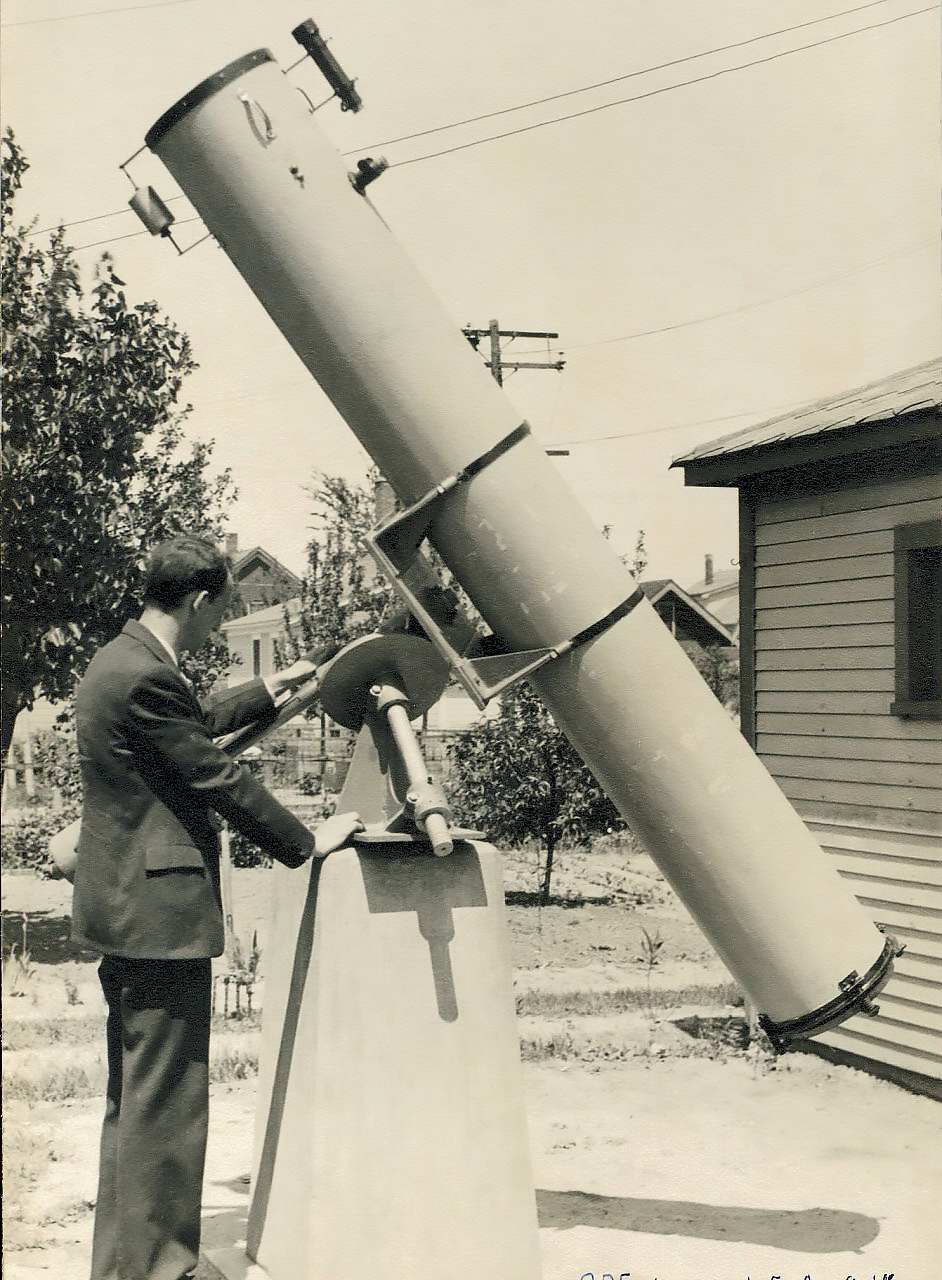 because of all the variable star observing and new observers, the AAVSO offered to lend Armfield
a 13 inch plate-glass mirror which he (and by extension the MAS) could use as long as they were doing variable star
observations. They did this to facilitate the observation of fainter variables. The offer was gladly accepted and
Armfield and several other members immediately started building a telescope and mount for the mirror which Armfield
funded. (That mirror remained in operation until 1961 when a new pyrex one was purchased. The old one was returned
to the AAVSO.) By October of that year, the telescope was hastily completed and installed in Armfield's backyard, seen here.
because of all the variable star observing and new observers, the AAVSO offered to lend Armfield
a 13 inch plate-glass mirror which he (and by extension the MAS) could use as long as they were doing variable star
observations. They did this to facilitate the observation of fainter variables. The offer was gladly accepted and
Armfield and several other members immediately started building a telescope and mount for the mirror which Armfield
funded. (That mirror remained in operation until 1961 when a new pyrex one was purchased. The old one was returned
to the AAVSO.) By October of that year, the telescope was hastily completed and installed in Armfield's backyard, seen here.
You can read about the entire history of this telescope (now known as the A-Scope) here.
Throughout 1934 Armfield was still the MAS Secretary/Treasurer and he presented many lectures to the membership and
talks to the public. In February the club established a newsletter that would eventually be called the MAS Bulletin.
Armfield's West Allis home was the postal address for the both the publication and the club's headquarters.
You can read those issues here.
In March of 1934 the MAS officially became a non-profit organization by filing Articles of Organization, a necessary
step if the club was to ever officially accept the offer and begin construction.

In this same year Armfield would step up his variable star observing. In the months of August, September, and October he recorded 1136 magnitude estimates. When the new 13-inch telescope became operational, it was used as intended: for were faint novae and faint variables at their minima.
Armfield's backyard with the 13 & 8 inch permanently mounted reflectors
Also in 1934, Armfield augmented his variable star observing by being elected to the AAVSO Council. He would serve 4 years, 3 of them as Vice-President.
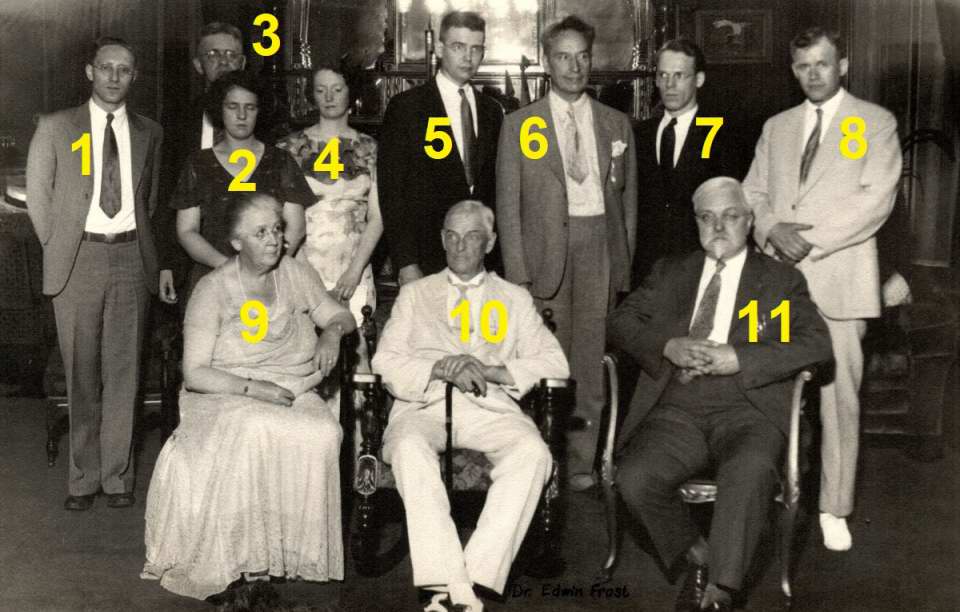
1. Luverne Armfield, 2. Dorothy Armfield, 3. Herbert Cornell, 4. Elizabeth Wight, 5. Ray Cooke, 6. Edwin Arthur de la Rulle,
7. Art Fotsch, 8. Ralph Buckstaff, 9. Mrs. Frost, 10. Dr. Frost, 11. Dr. Barnett
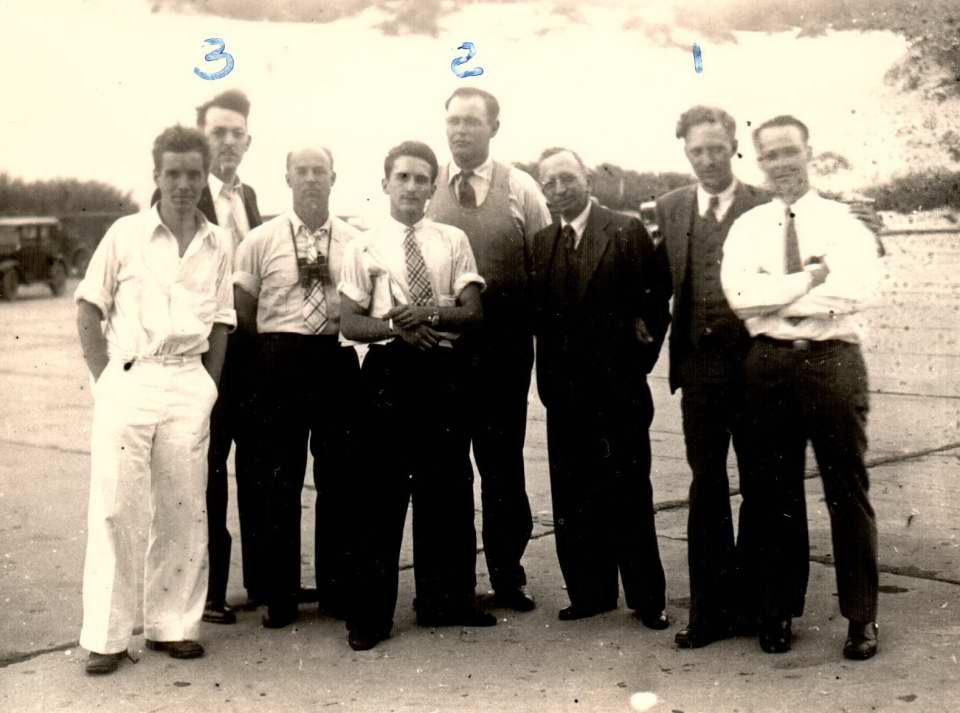
1. Luverne Armfield, 2. Peck, 3. Ed Halbach
Armfield's AMS duties continued as he recorded an accounting of the WI-NIL regional group's accomplishments for the year.
They made observations to determine meteor heights of the Eta Aquarids in May, the Pons-Winnecke-ids in late June, the
Perseids in August, and observers watched the 1934 Leonids, which did not produce a storm.
After the Leonids Armfield identified another scientific meteor project for the WI-NIL region's observers:
the Hoffmeister-Olivier Program which required making half-hour meteor counts during those periods when there were
no major meteor showers. The Wisconsin-Northern Illinois group contributed 2526 meteors during 98 watches in 1935
and Olivier proclaimed its work "outstanding." Armfield's personal meteor contribution in 1935 were 58 more telescopic
meteors whose magnitudes were estimated during his time observing variable stars.

Armfield and his family were featured in a Milwaukee Journal article on May 10, 1934.
Note: The part of the article that's shown is just for basic display. Due to copyright, it has been reduced to a size
and resolution where it cannot be read. If you are a member of the MAS, we own a copy of this and it is available for viewing at our observatory.
1935
An early highlight of 1935 was the visit of Dr. Harlow Shapley who was the Director of the Harvard Collage Observatory on January 13, 1935. Dr. Shapley was in town to give a lecture at the Harvard Club of Milwaukee on Saturday and it was well attended by MAS members. He graciously offered to meet with the variable star section of the club for a discussion of observational problems the following morning (Sunday) at the home of Armfield.The Sunday morning session was opened by Dr. Shapley with a discussion of Nova Herculis and the importance of the observations contributed by amateurs. There was then a lively discussion with the group concerning variable star work. As his time was running short he asked to see the equipment which he had glimpsed in the rear yard when he arrived. Everyone then retired to the yard for an inspection of Armfield's telescopes, charts, and auxiliary equipment that the society used in their variable star work.

The meeting ended with Dr. Shapley kindly agreeing to pose with the group for a photo. In that picture is Luverne Armfield at the lower left with Dorothy Armfield (his wife) at the very left. Kneeling at the right is Walter Scott Houston who is next to Armfield's daughter, Laurel Jean. Click/tap here for a name key.
A similar visit was made on August 9th by Dr. Charles Oliver, a professor at the University of Pennsylvania and president of the American Meteor Society. The following day when he was talking to the Amateur Telescope Makers of Chicago he credited Armfield "whose efforts the meeting ... made possible."
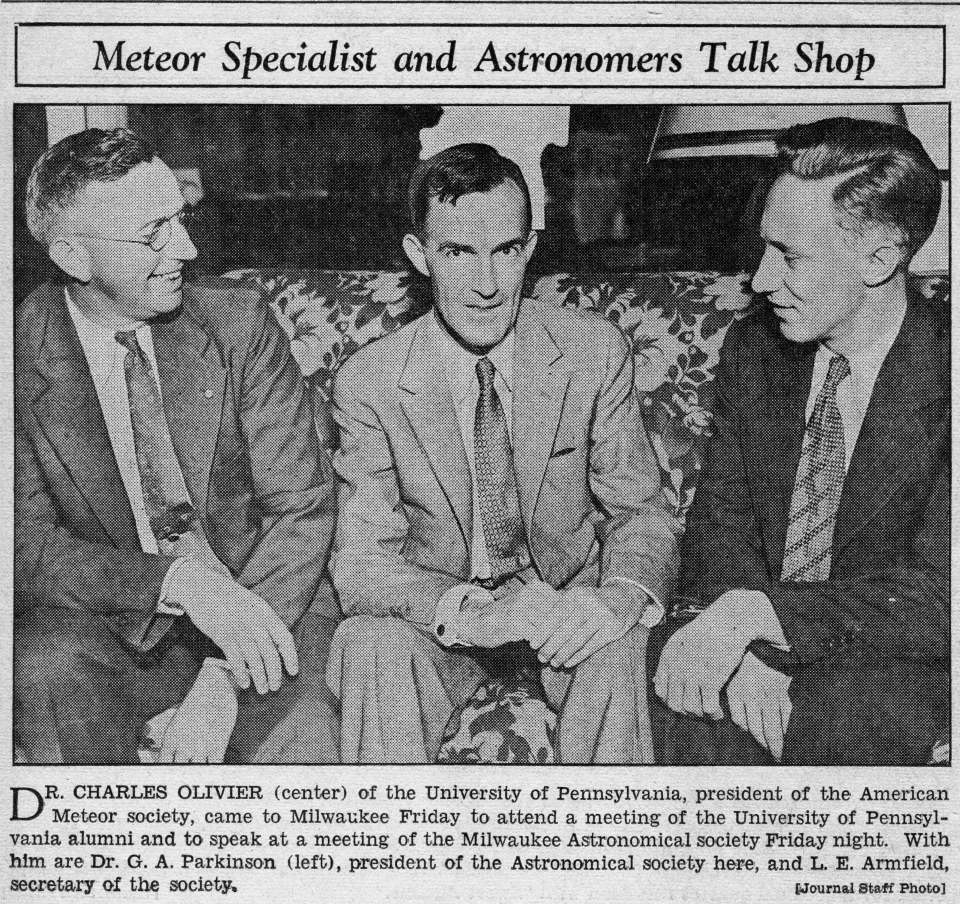
1935 - American Amateur Astronomical Association
The most significant event of 1935 was the formation of the American Amateur Astronomical Association (AAAA), a joint idea of Armfield's and J. Wesley Simpson. Simpson was the Director of the Missouri-Southern Illinois Observers (M-SIO) and the editor of their publication, the Astronomical Discourse. Along with the Madison Astronomical Society, they are the charter members of the AAAA.The decision to form the AAAA was reported in the MAS Bulletin of May, 1935 and you can read that article here.
The idea of the AAAA was to form a federation of amateur astronomy clubs modeled after the British Astronomical Association for the purposes coordinating astronomical observations, information exchange, and especially the promotion of serious astronomy which included variable stars, meteors, occultations, lunar, solar, planetary, and nova search. Eventually, they would also include telescope making and observatory construction.
1936
 In January of 1936 the AAAA started publishing a monthly bulletin called Amateur Astronomy (AA). The publication
headquarters was Armfield's home with Miss Elizabeth Wight the editor. In the photo at the left shows the entire
editorial staff. Wight is at the center, Ed Halbach at the upper left, William Liebscher at upper right, A. K. Fisher
at lower right, and Carolyn Nickels at the lower left.
In January of 1936 the AAAA started publishing a monthly bulletin called Amateur Astronomy (AA). The publication
headquarters was Armfield's home with Miss Elizabeth Wight the editor. In the photo at the left shows the entire
editorial staff. Wight is at the center, Ed Halbach at the upper left, William Liebscher at upper right, A. K. Fisher
at lower right, and Carolyn Nickels at the lower left.
The AA consisted of general observing activities with specific articles from the individual member societies. Several of these clubs (including the MAS) stopped publishing their own newsletter and distributed this journal instead.
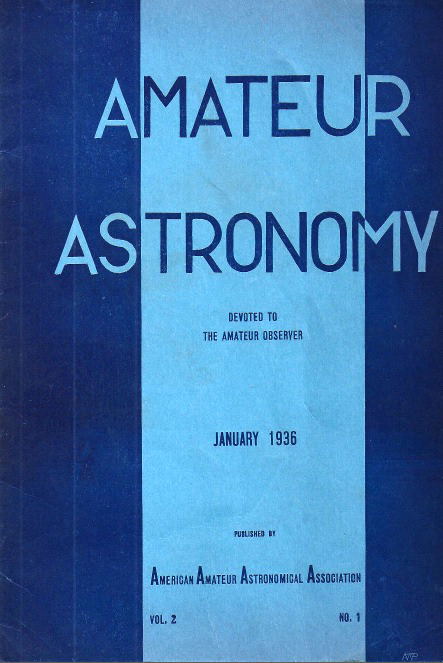 It was a high quality publication and by the end of that year, there were 12 member societies and as editorial
advisors had Leon Campbell of the AAVSO and Charles P. Oliver of the AMS.
It was a high quality publication and by the end of that year, there were 12 member societies and as editorial
advisors had Leon Campbell of the AAVSO and Charles P. Oliver of the AMS.
Armfield's duties for the AAAA organization was to summarize the variable star results from the local societies
in the "Variable Star Section Notes" column published in the AA. Not waiting for the first issue of the AA, Armfield
was already doing this in the MAS Bulletin in the May 1935 issue.
The publication expense of Amateur Astronomy, with the exception of a small annual fee paid by member societies,
was borne by Armfield. The subscription fee was not large enough to cover the expenses of printing and mailing the monthly bulletins.
You can read all those issues here.
Luverne Armfield (right) at the AAVSO Spring Meeting, New York City
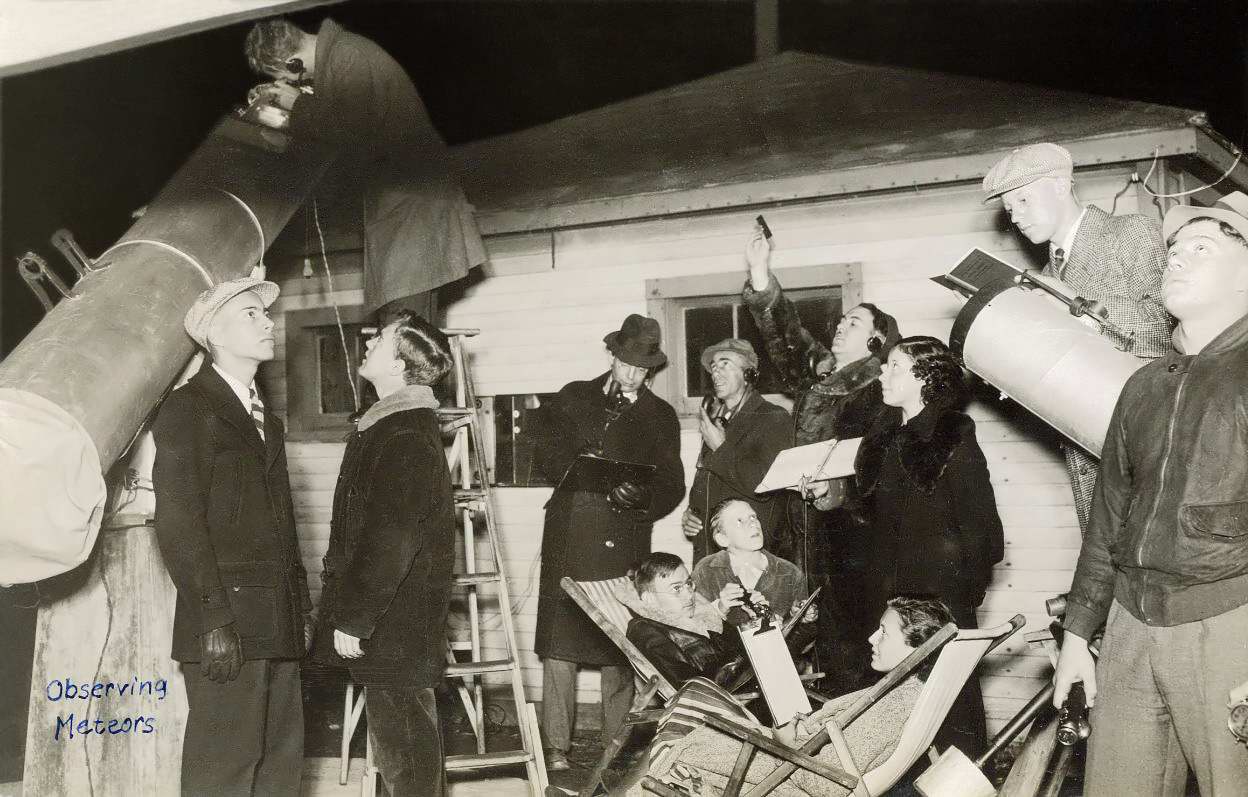 1936 also saw the MAS start a program of coordinated duplicate meteor observing using short wave radio communication
for the purpose of doing height calculations of meteors headed by Ed Halbach. Though the results that Armfield and Halbach
achieved with their coordinated efforts in matching meteor sightings were considered very good, both were actually
disappointed that more weren't adequately plotted and matched. But Ed Halbach hatched a plan to coordinate the observations
in real-time by utilizing short-wave radio. Though in theory this could be done via a telephone call, at that time long distance
calls were prohibitively expensive.
1936 also saw the MAS start a program of coordinated duplicate meteor observing using short wave radio communication
for the purpose of doing height calculations of meteors headed by Ed Halbach. Though the results that Armfield and Halbach
achieved with their coordinated efforts in matching meteor sightings were considered very good, both were actually
disappointed that more weren't adequately plotted and matched. But Ed Halbach hatched a plan to coordinate the observations
in real-time by utilizing short-wave radio. Though in theory this could be done via a telephone call, at that time long distance
calls were prohibitively expensive.
On its surface the observations for the height calculations sounds very simple. However, in practice it proved extremely difficult to almost impossible. First, it was difficult to get the decent plot accuracy. It took an experienced observer and that person had to be looking at the right part of the sky. The closer that observer was looking to where the meteor appeared, the more accurate the plot. Second, the odds of another qualified observer seeing the same meteor to make a duplicate plot with the necessary precision were extremely low. Third, just looking at the plots and times it wasn't always certain the two meteor plots were in fact the same meteor! The time had to be very precisely noted and in that era having the necessary accuracy was difficult.
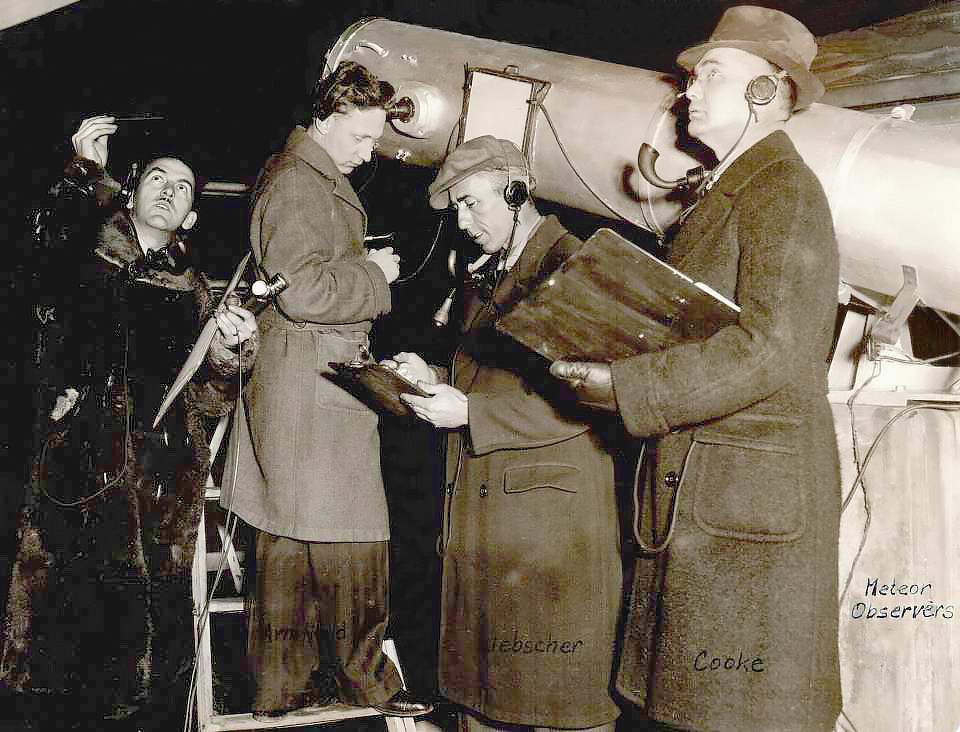 Doing coordinated meteor watching via short-wave with HAM radio enthusiasts helped to overcome these issues.
Rather than two random observers being paired after the fact, the meteor observations would be coordinated so
that observers could agree on when and where to look. But even better was that this all happened in real-time
coordination so there would be no question that they were observing the same meteor.
Doing coordinated meteor watching via short-wave with HAM radio enthusiasts helped to overcome these issues.
Rather than two random observers being paired after the fact, the meteor observations would be coordinated so
that observers could agree on when and where to look. But even better was that this all happened in real-time
coordination so there would be no question that they were observing the same meteor.
It helped solve the various problems. 1) Precision of the plots was elevated by the observers agreeing on where
they should be looking. And if it was desirable to change that location, they could immediately agree. 2) You were
guaranteed that the other observer was equally qualified. 3) There was no doubt that the two observers had just seen
the same meteor. In this case precise timing was not actually needed.
Read Ed Halbach's AAAA article about the duplicate meteor observation program here.
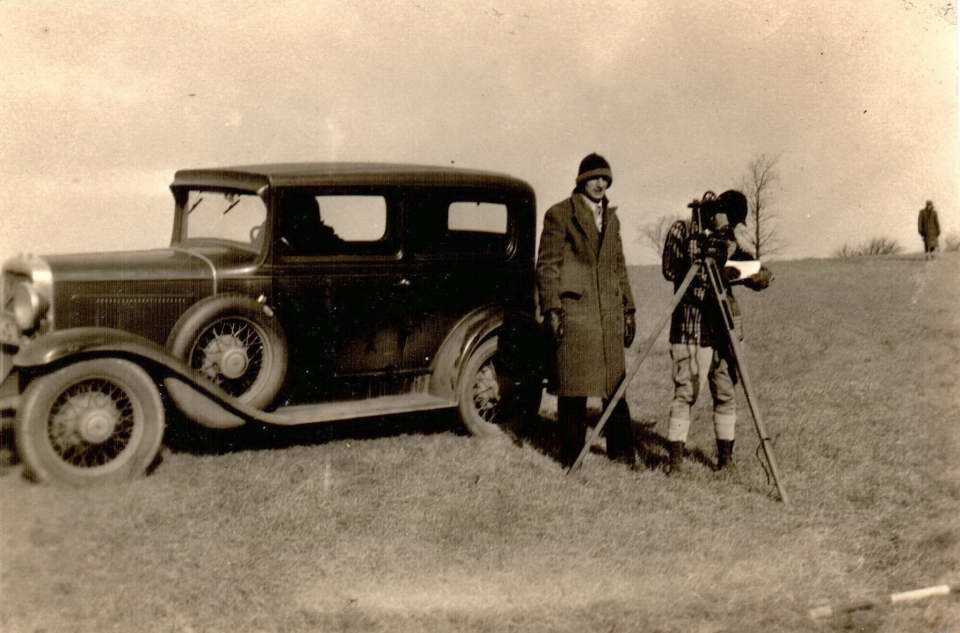 In October of 1936,
Armfield had to move from his house as a result of a divorce. This
decommissioned the 13 inch telescope and it was the loss of the unofficial
site of the MAS observatory. But there were two silver linings: 1) This
allowed additional work on the telescope. The original wooden mirror box
which was replaced with a proper mirror cell. A sidereal drive, setting
circles, and slow motions in both axes were added. 2) It lit a fire under
the MAS to finally act on the land offer by Phillips and start
development. The picture shows
members Frister and Dieter in the late fall of 1936 surveying the property for the start of the
development.
In October of 1936,
Armfield had to move from his house as a result of a divorce. This
decommissioned the 13 inch telescope and it was the loss of the unofficial
site of the MAS observatory. But there were two silver linings: 1) This
allowed additional work on the telescope. The original wooden mirror box
which was replaced with a proper mirror cell. A sidereal drive, setting
circles, and slow motions in both axes were added. 2) It lit a fire under
the MAS to finally act on the land offer by Phillips and start
development. The picture shows
members Frister and Dieter in the late fall of 1936 surveying the property for the start of the
development.
1937 - Construction of Observatory Begins
The development itself started in 1937. It was decided that they should go with the original plan which is shown below:The building which would be started in July would be the first of several units which would become one larger complete building. When funds were secured, a second unit of about the same size as the first would be constructed 50 feet directly west and the two buildings connected by a one-story office/meeting hall which could be heated. Directly north of the center point between the two domes, there would be a larger unit to house possibly a 20 to 30 inch reflector.
But there was a slight detour because A. C. Tabbott donated the 8" f/15 reflector that he commissioned the MAS to build along with the rollaway structure that was made to house the instrument. The scope and structure was completed on July 5, 1937.
When the 8" telescope and shelter were complete, ground was broken for the domed observatory by the digging of a hole six feet deep to receive the form for the pier. The construction would last through the late fall until the dome was complete.
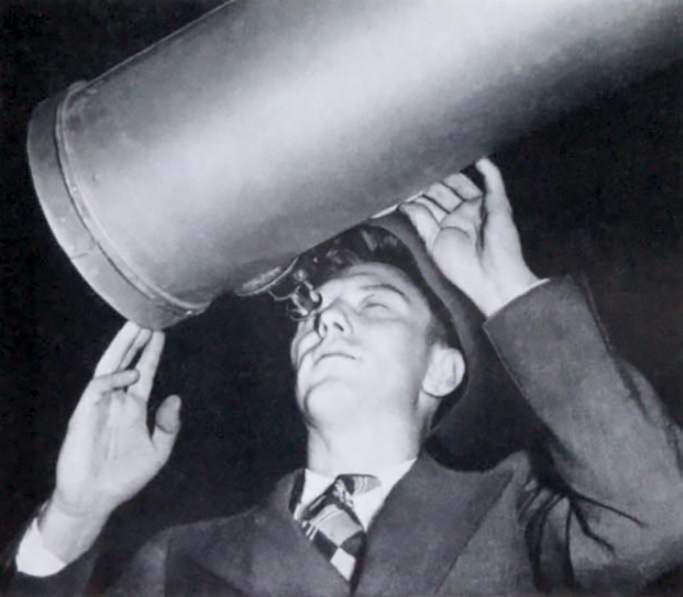 In the summer of 1937 the Milwaukee Journal had an article, "Home-Made Telescopes open the Heavens to Amateurs." It featured Armfield at the
eyepiece of then newly installed 8 inch f/15 reflector at the MAS Observatory. The article was republished the following year in the national
magazine, The Sky.
In the summer of 1937 the Milwaukee Journal had an article, "Home-Made Telescopes open the Heavens to Amateurs." It featured Armfield at the
eyepiece of then newly installed 8 inch f/15 reflector at the MAS Observatory. The article was republished the following year in the national
magazine, The Sky.
1938
On the 25th of March the MAS took possession of the property. Early in May, exactly 10 months after construction had started, Armfield's renovated 13 inch telescope was mounted on the pier.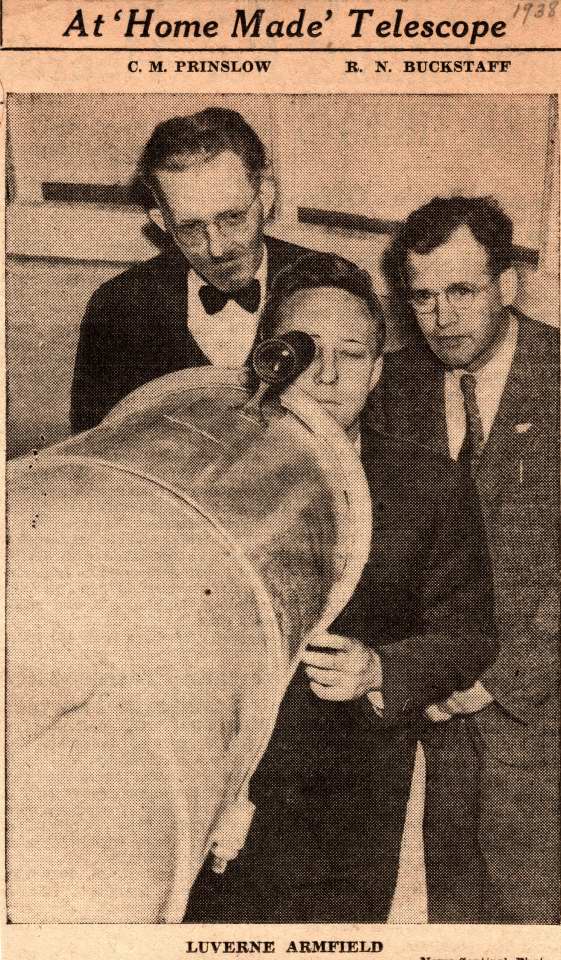 On June 18th, the observatory was officially dedicated and over 100 members and guests came to the event, many of
them from Chicago, Madison, and other outside areas. There was a picnic dinner and when it was finally dark enough
for slides to be seen, Ed Halbach, who was President at the time, presided over the event. M. J. W. Phillips
made the dedicatory address which included a brief story of the building, illustrated by lantern slides of the
various stages of construction. The main address was by Charles Hetzer of the Yerkes Observatory. As the sky was clear,
the rest of the evening was taken up observing with the 13 inch scope in the building and many other instruments
belonging to the members which were scattered about the grounds. The local paper took a photo of Armfield at his
13-inch telescope which was published a few days after the dedication.
On June 18th, the observatory was officially dedicated and over 100 members and guests came to the event, many of
them from Chicago, Madison, and other outside areas. There was a picnic dinner and when it was finally dark enough
for slides to be seen, Ed Halbach, who was President at the time, presided over the event. M. J. W. Phillips
made the dedicatory address which included a brief story of the building, illustrated by lantern slides of the
various stages of construction. The main address was by Charles Hetzer of the Yerkes Observatory. As the sky was clear,
the rest of the evening was taken up observing with the 13 inch scope in the building and many other instruments
belonging to the members which were scattered about the grounds. The local paper took a photo of Armfield at his
13-inch telescope which was published a few days after the dedication.
The last issue of the AA was the June-July 1938 issue as Armfield could not get the member organizations to contribute enough financial support and Armfield himself could no longer, either as he experienced some financial setbacks himself. We suspect that he made every effort to make sure that last issue got published because the lead story was about the new MAS observatory. Without the AA publication the AAAA collapsed soon after.
Though the AAAA can obviously be viewed as a failure, it was not without remarkable success. By the end there were 15 member societies/clubs from as far away as New York and California so it was a national organization. And it was a success in the mission that it promised. As far as we can tell the failure was entirely financial. And though it may seem easy now to be critical of that, remember this was all done in the middle of the Great Depression. But the real success was that the idea was resurrected after World War II when in 1947 the Astronomical League was formed with Ed Halbach its first President. That organization still exists and is active and vital having both national and regional conferences and publications.
1939-1944
By 1939 Armfield's activities with the MAS were winding down significantly since all of his spare time was put into trying to unionize the office engineering staff and office workers at the Wisconsin Telephone Company. He was highly successful in this endeavor. As much as Armfield had positively contributed to the club when he was active, his absence was bound to be negative. After that last issue of AA, the MAS had no publication / newsletter whatsoever and it wouldn't be resurrected again until 1958!The observatory was essentially closed from 1942-1945 with World War II and gas rationing. And the meteor watch program using short wave radio was silenced.
Around 1943 Armfield and Halbach set up an optical shop at the home of Armfield and at the observatory making roof prisms for the war effort. For this they received extra gas stamps allowing some travel to the observatory. But it proved difficult to get the necessary precision and the venture ultimately failed. Our records show he got elected to Secretary for the 1943-1944 term, indicating he would once again be active in the club. But in 1944 he resigned from that position as he left Milwaukee for a new job and moved to Indiana.
1945-1977
He married for a second time in 1948 to Edith May "Teeny" Helgeson in New Albany, Indiana. In 1949, the couple had moved to where he was a commercial manager for the Elyria Telephone Company. In 1951 the Armfields moved to Fargo, North Dakota.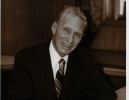 In Fargo, Armfield founded a consulting firm, Communication Consultants, Inc., using the technical and business
experience he had developed while working for telephone utilities. In 1954, he was described as a communications
engineer and he served as an advisor to seven rural telephone associations that were to buy the North Dakota Telephone Company.
In Fargo, Armfield founded a consulting firm, Communication Consultants, Inc., using the technical and business
experience he had developed while working for telephone utilities. In 1954, he was described as a communications
engineer and he served as an advisor to seven rural telephone associations that were to buy the North Dakota Telephone Company.
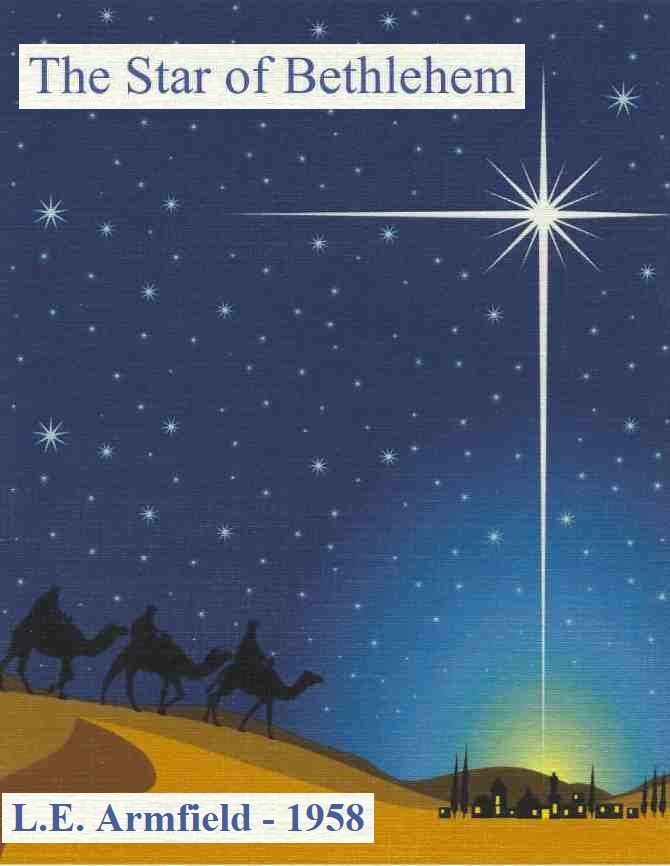 While living in Fargo, Armfield's enthusiasm for astronomy continued and he shared it with Fargo neighbors like he
did in Milwaukee. He and "Dewey" Bergquist, a local weatherman with WDAY, Channel 6 TV became close friends as both
had an interest in the universe. They went on to host 'Star Parties.' In 1960 or 1961, they were cohosts of a TV show
called 'Out of this World' where they would explore the universe and take questions from callers." Armfield apparently
felt comfortable in front of a television audience and camera and he frequently appeared on another daily TV program that
was unrelated to astronomy.
While living in Fargo, Armfield's enthusiasm for astronomy continued and he shared it with Fargo neighbors like he
did in Milwaukee. He and "Dewey" Bergquist, a local weatherman with WDAY, Channel 6 TV became close friends as both
had an interest in the universe. They went on to host 'Star Parties.' In 1960 or 1961, they were cohosts of a TV show
called 'Out of this World' where they would explore the universe and take questions from callers." Armfield apparently
felt comfortable in front of a television audience and camera and he frequently appeared on another daily TV program that
was unrelated to astronomy.
In 1958 Armfield wrote an article on the Star of Bethlehem and could it be explained scientifically. It is a very thorough account of various possibilities to explain what it was. The article was given to us by Armfield's daughter, Connie Stenhjem, with permission to publish it here on this website. We are proud to be able to share this.
Luverne Armfield passed away on April 23, 1977.
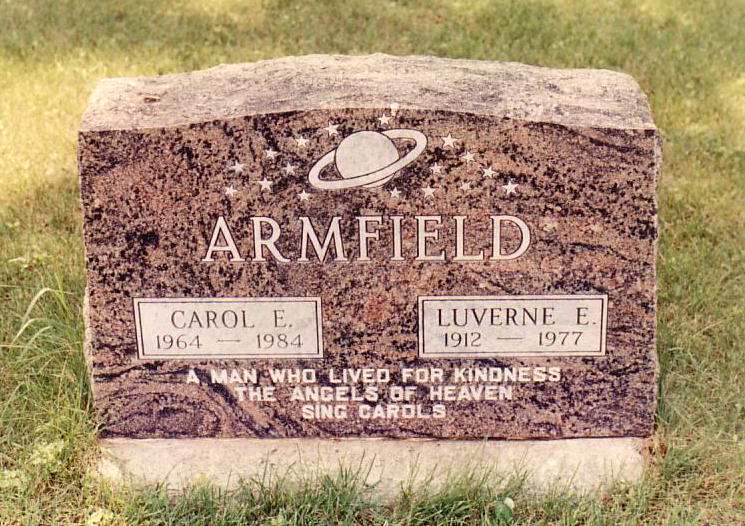
Armfield's Legacy at the MAS
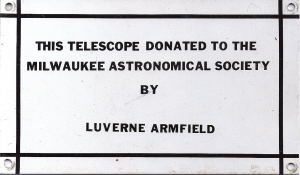 At
our club, our main observatory building is officially the
Armfield Observatory, but almost everyone calls it the "A" Dome.
(Many members don't realize that "A" stands for Armfield.) The first
floor of that observatory was totally renovated in 2017 and in 2019 the
upper floor was updated. The telescope is mounted on the pier on that
second floor is the Edward A. Halbach Telescope,
but everyone refers to it as the "A" Scope. The reason is until 1977 it was the Luverne Armfield Telescope and hence, got the
name "A" for Armfield. The original mirror got replaced with a pyrex mirror in 1961 and in the scope was completely
refurbished in 1977 and rededicated. Though it was briefly referred to as the "H" Scope, but soon everyone was calling it
the "A" Scope again.
At
our club, our main observatory building is officially the
Armfield Observatory, but almost everyone calls it the "A" Dome.
(Many members don't realize that "A" stands for Armfield.) The first
floor of that observatory was totally renovated in 2017 and in 2019 the
upper floor was updated. The telescope is mounted on the pier on that
second floor is the Edward A. Halbach Telescope,
but everyone refers to it as the "A" Scope. The reason is until 1977 it was the Luverne Armfield Telescope and hence, got the
name "A" for Armfield. The original mirror got replaced with a pyrex mirror in 1961 and in the scope was completely
refurbished in 1977 and rededicated. Though it was briefly referred to as the "H" Scope, but soon everyone was calling it
the "A" Scope again.

